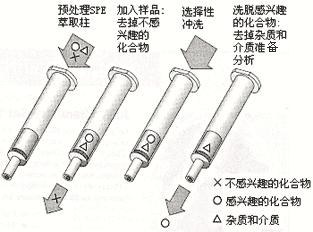First, referring to the type and application of the solid phase extraction column, select the appropriate packing type, and then select the size and packing amount of the solid phase extraction column.
Sample size
Extraction column size
1ml
1ml
1ml ~ 250ml, and the extraction speed is not required
3ml
1ml ~ 250ml, requires rapid extraction
6ml
10ml ~ 250ml, requires high sample capacity
12, 20 or 60ml
<1L, and the extraction speed is not required
12, 20 or 60ml
100ml ~ 1L
47mm
> 1L and require high sample capacity
90mm
Reverse phase, normal phase and adsorption type processes:
The mass of the extracted sample does not exceed 5% of the amount of packing in the column, that is, if you
With a 100 mg / 1 ml solid phase extraction column, the analytical substance does not exceed 5 mg.
Ion exchange process:
You must consider the capacity of ion exchange: SAX and SCX have an adsorbent capacity of 0.2 m
Equivalent / gram.
The mass of the extracted sample does not exceed 5% of the amount of packing in the column, that is, if you
With a 100 mg / 1 ml solid phase extraction column, the analytical substance does not exceed 5 mg.
Ion exchange process:
You must consider the capacity of ion exchange: SAX and SCX have an adsorbent capacity of 0.2 m
Equivalent / gram.
Second, after selecting the extraction column, perform the extraction process according to the four steps shown in the figure:

Step 1: Pre-treat the extraction column.
Before extracting the sample, flush the tube with a full tube of solvent in order to wet the packing of the solid phase extraction column. Reverse phase type silica gel and non-polar adsorbent medium, usually water-soluble organic solvent
Agents such as methanol are pretreated, and then water or buffer solution. Methanol wets the adsorbent surface and infiltrate the bonded alkyl phase to allow water to wet the silica surface more effectively. Sometimes pre-treatment solvent
Use before methanol. These solvents are usually the same as the elution solvents, which are used to eliminate impurities on the solid phase extraction tube and their interference with the analyte, or the impurities may only be soluble in strong elution solvents.
Before extracting the sample, flush the tube with a full tube of solvent in order to wet the packing of the solid phase extraction column. Reverse phase type silica gel and non-polar adsorbent medium, usually water-soluble organic solvent
Agents such as methanol are pretreated, and then water or buffer solution. Methanol wets the adsorbent surface and infiltrate the bonded alkyl phase to allow water to wet the silica surface more effectively. Sometimes pre-treatment solvent
Use before methanol. These solvents are usually the same as the elution solvents, which are used to eliminate impurities on the solid phase extraction tube and their interference with the analyte, or the impurities may only be soluble in strong elution solvents.
Normal phase type solid phase extraction silica gel and polar adsorbent medium, usually pretreated with the organic solvent where the sample is located. Ion exchange packing will be used for samples in non-polar organic solvents, which are pretreated with 3-5ml of deionized water or low concentration ion buffer solution. In order to keep the solid phase extraction material wet from pretreatment to sample addition, allow about 1 ml of pretreatment solvent to be on the surface of the tube filter (frit) or extraction plate. If the sample is introduced into the solid phase extraction tube from a storage tube or filter tube, then add 0.5 ml of the final pretreatment solvent to the 1 ml solid phase extraction tube. Add 4 liters to a 6 ml tube and so on. This is to ensure that the extraction column is wet before the sample is added. If the packing in the extraction column dries before the sample is added, repeat the pretreatment process. Before reintroducing the organic solvent, rinse the salt of the buffer solution in the column with water.
Step 2: Add samples.
Load the sample into the extraction column. At this time, the packing in the solid-phase extraction cartridge will adsorb the compound of interest or impurities in the sample. In this way, when the sample flows out, the selected compounds (including impurities) are left on the extraction column.
Step 3: Rinse the filler.
The impurities are washed with a rinsing solution strong enough to elute the impurities and weak enough to retain the compound of interest.
Step 4: Elute the compound of interest.
The compound adsorbed on the extraction column is eluted in the solution with a solvent.
Silicone Kneading Dough Mat,Eco-Friendly Dough Mat,Pastry Baking Dough Mat,Baking Dough Mats
Changshu Xinneng Silicone Products Co., Ltd. , https://www.xnmat.com